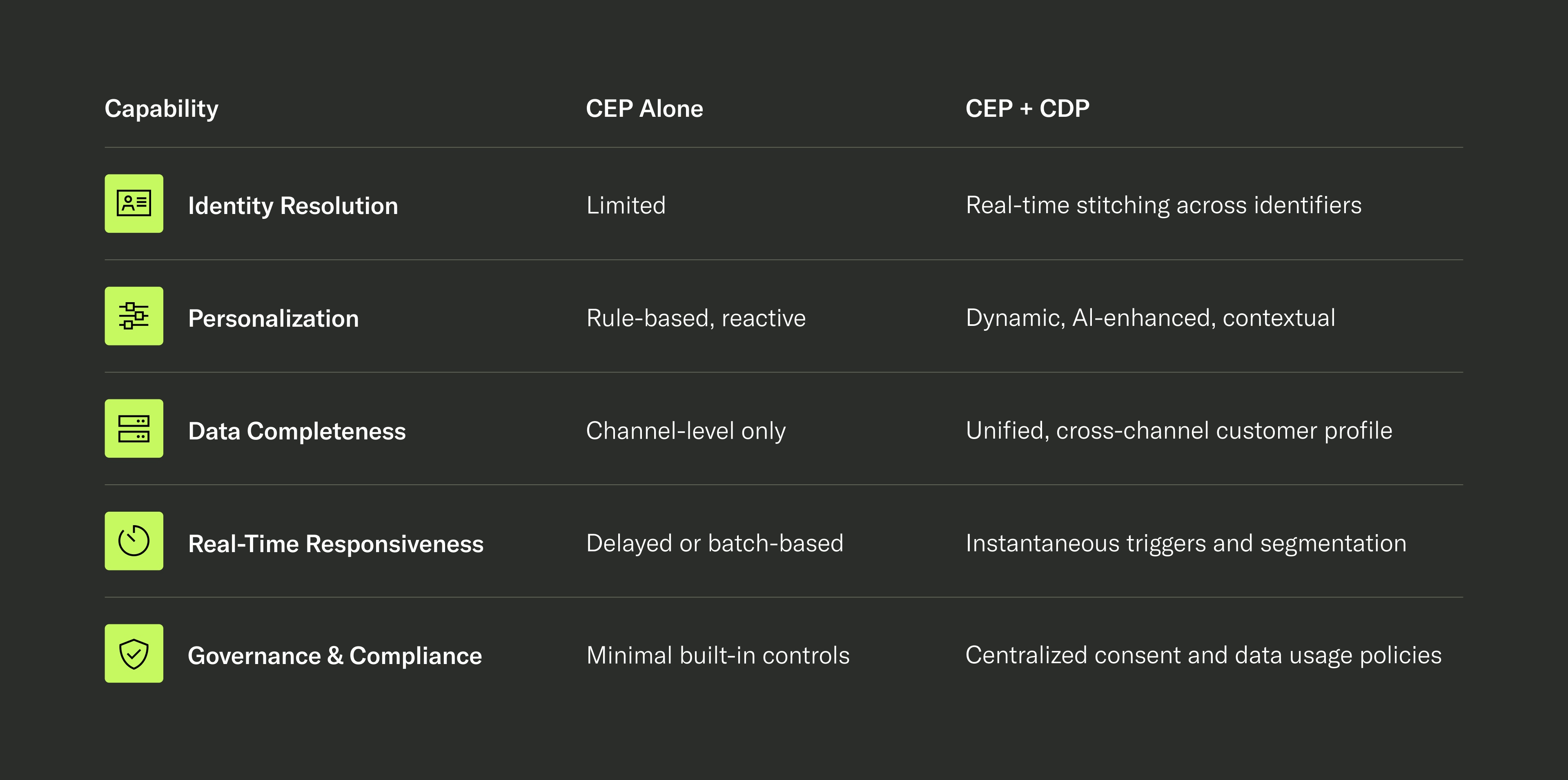Introduction
With each new wave of technology, consumer expectations leap forward, raising the bar for personalization, immediacy, and seamless brand interactions. Whether they’re shopping online, tapping through a mobile app, or receiving support via live chat, people expect custom and frictionless experiences. Meeting these expectations has become a business imperative, and for many organizations, the go-to solution is a customer engagement platform (CEP) that orchestrates and measures interactions across every channel.
However, while CEPs excel at managing triggers, workflows, and communication paths, they struggle without clean, well-governed data. That's where customer data platforms (CDPs) come in. The right enterprise-grade CDP ensures the data feeding your CEP is reliable, accurate, and real-time, unlocking richer personalization, compliance at scale, and a better experience for both your team and your customers.
Understanding customer engagement platforms
What are CEPs?
A CEP acts as the central hub for customer interactions, managing both outbound and inbound communications.
Specifically, modern CEPs enable:
- Omnichannel orchestration: Coordinating messaging across channels in a synchronized way that doesn't lead to any overlap, redundancies, or confusion. In practice, this could look like a retailer sending an abandoned cart email prompting a customer to complete a purchase and their CEP triggering a push notification through the app if they don't respond within 24 hours.
- Personalization: Customizing content and offers based on user behavior or attributes. For example, a food delivery service's CEP taps into user-specific history to craft individualized rewards or discounts. A frequent coffee buyer might see a push notification for a discounted latte, while a customer who usually orders burgers gets a personalized in-app offer for a buy-one-get-one burger deal.
- Analytics: Measuring engagement, conversions, and overall campaign performance. For instance, a streaming platform can track how many customers click on a recommendation in their app, and the CEP can then tie these clicks to subsequent subscription upgrades or cancellations to show how each campaign impacts revenue and churn.
Why CEPs matter
Enterprises use customer engagement platforms to move beyond siloed solutions like standalone email tools or SMS gateways. A CEP unifies messaging under one roof, making it easier to:
- Engage customers in real time on their preferred channels (e.g., web, mobile app, social, text, etc.).
- Facilitate more robust self-service options (e.g., chatbots equipped to answer FAQs and surface materials with the support of a dynamic content management system).
- Reduce churn by identifying at-risk users early and deploying timely interventions.
- Improve customer lifetime value (LTV) with targeted upsells, cross-sells, and loyalty programs.
- Measure engagement holistically, giving teams a complete picture of how messaging impacts key metrics.
Despite these substantial benefits, most CEPs can only go so far on their own. Common data quality issues and governance gaps can limit their true potential.
Why CEPs alone fall short
Engagement platforms can coordinate messages, measure click-through rates, and make it easier for customers to get the answers they need. However, they often struggle to meet customers’ increasingly robust expectations. This is largely due to issues in the underlying data, such as:
Data fragmentation
Customer data exists across a number of different channels, from websites and mobile apps to in-store interactions, loyalty programs, and more. While CEPs can help unify engagement across all these channels, they can’t always unify all the data sources or handle complex identity logic in one place.
Incomplete view of the customer
True personalization requires a comprehensive single-customer profile that captures behaviors, preferences, and interactions over time. Growing complexity in enterprise ecosystems means that many CEPs lack advanced data governance, compliance, or identity resolution features out-of-the-box, making it difficult to connect a single user’s interactions across multiple touchpoints. Without robust identity stitching (i.e., combining IDs, emails, phone numbers, or device fingerprints into one profile), your CEP may only see slices of the customer journey. This inconsistent approach leads to generic experiences and missed opportunities for conversion and building customer loyalty.
Performance and real-time limitations
While many CEPs do have basic data integration capabilities, they struggle with real-time ingestion of behavioral data. Enterprises dealing with high-volume event streams can quickly overwhelm a CEP’s native data processing capabilities. Meanwhile, advanced use cases, such as machine learning models used for predictive segmentation, need a specialized data layer that can handle low-latency operations at scale.

The CDP: A foundation for data maturity
A CDP helps to solve many of these CEP challenges by providing reliable infrastructure that delivers complete, consistent, and compliant customer data wherever it’s needed.
Best-in-class CDPs will:
- Resolve identity and unify customer data: Resolve fragmented identifiers and tie them to standardized, cross-channel data in a single profile. This ensures early recognition, consistent personalization, and accurate measurement across every touchpoint.
- Enable real-time activation across every channel: Stream enriched customer data instantly into your CEP, ad platforms, and analytics tools so experiences reflect the most up-to-date context.
- Enforce governance and streamline compliance: Enforce consent, access controls, and data usage policies across systems—making it easier to move quickly without increasing risk.
- Unlock predictive insights to optimize performance: Use behavioral signals and AI-enriched traits to anticipate customer needs, refine targeting, and improve performance across campaigns.
These capabilities create a scalable, future-ready foundation for customer engagement—one that evolves with your strategies and keeps your personalization sharp.
The CDP ecosystem is evolving
As businesses demand even more from their data infrastructure, a new generation of CDPs is emerging. These next-gen CDPs emphasize:
- Zero- or low-copy architectures: They minimize data duplication to keep quality and governance under tight control while reducing overhead.
- Compute optimization: Modern CDPs can handle large-scale, real-time workloads for AI-driven insights without sending cloud costs sky-high.
- Holistic insights: They go beyond basic segmentation to surface deeper, AI-powered intelligence that can rapidly personalize experiences based on real-time and historical data.
In short, CDP 2.0 is all about boosting the performance and sustainability of customer data processes, so teams spend less time fixing data problems and more time creating meaningful interactions.
Key benefits of integrating your CEP with a modern CDP
A CEP is only as powerful as the data that drives it. When you feed a CEP with high-quality unified customer data, you're bound to see a dramatic improvement in the relevance of every message, offer, or notification you send. This synergy is particularly crucial at the enterprise level, where data fragmentation and siloed workflows can undermine even the most sophisticated engagement strategies. Other benefits of combining these two powerful systems include:
Unified profile and identity resolution
A modern CDP excels at stitching together cross-channel identifiers (e.g., device IDs, emails, phone numbers, or loyalty IDs) into a single, persistent customer profile. This unified view ensures that when someone redeems a coupon in-store or visits your website, for example, the information is instantly updated across all channels. Rather than guessing who’s who, your CEP relies on an accurate, always-fresh identity record to coordinate timely, relevant campaigns.
Real-time relevance
Although many CEPs tout real-time capabilities, they often struggle with delivering on these promises because of delayed or incomplete data. A modern CDP resolves this by continuously streaming events into your engagement platform as they happen. That means the moment a user triggers a high-intent action—like adding items to a cart or tapping on a push notification—your CEP can respond with context-aware follow-ups. In an era of short attention spans and high consumer expectations, immediate, tailored engagements can significantly boost conversions and brand loyalty.
Stronger governance and compliance
Data governance is essential—especially for enterprises in regulated industries like finance and healthcare. Modern CDPs provide robust consent management, flexible data routing, and privacy tools to handle sensitive information at scale. By centrally enforcing these policies, you can confidently run automated engagement campaigns without worrying about regulatory issues or brand-damaging mistakes.
Efficiency and cost savings
The newer generation of CDPs emphasizes architectures that minimize wasteful data duplication and optimize compute resources. This helps your CEP process large-scale, real-time data streams without bogging down. Reducing data redundancy helps curb spiraling costs in cloud data warehouses or real-time analytics pipelines.

How to get started
As you explore integrating your CEP with a CDP, we recommend taking the following steps:
- Evaluate your data stack: Take stock of all the sources generating customer data. Identify gaps in identity resolution, latency, or governance. This audit will highlight the must-have features in both your CEP and CDP.
- Choose the right CEP and CDP platforms: Look for solutions that not only cover your current channels but can scale to future needs. Make integration a core criteria, as bi-directional data flow between your chosen CEP and CDP is crucial.
- Connect the dots: Prioritize high-impact use cases, such as abandoned cart recovery, churn prevention campaigns, or upsell offers for loyalty members. Identifying early wins will help validate the synergy between your CEP and CDP and prove the ROI to stakeholders.
- Refine and scale: As you build confidence in your setup, start leveraging CDP-powered insights to refine segments, journeys, and personalization logic. Use advanced analytics and AI models to uncover new micro-segments and make dynamic recommendations.
Embracing a new era of CDP to future-proof customer engagement
As customer engagement tools evolve, simply having a CDP or CEP won't be enough. CDP 2.0 marks a shift toward intelligent data orchestration, advanced identity resolution, and compute optimization for AI-driven marketing—what we refer to as a “zero-waste” approach. Minimizing unnecessary data duplication will not only streamline performance and costs but also reinforce your commitment to high data quality and regulatory compliance.
By aligning your CEP with a next-gen CDP, you’ll be ready for emerging trends like agentic AI marketing (where systems independently optimize campaigns in real time) and granular micro-personalization. In a market where customers demand hyper-relevance in every interaction, this level of agility and precision can be your biggest competitive advantage.
The next step? By combining real-time identity resolution, governance-focused data management, and optimized compute capabilities, you’ll fuel the kind of personalized, frictionless experiences that drive brand loyalty and revenue growth.
Ready to see how a robust, future-proof CDP can amplify your CEP strategy? Explore CDP 2.0 in our latest content series and discover how you can orchestrate your data more intelligently.







.avif)
